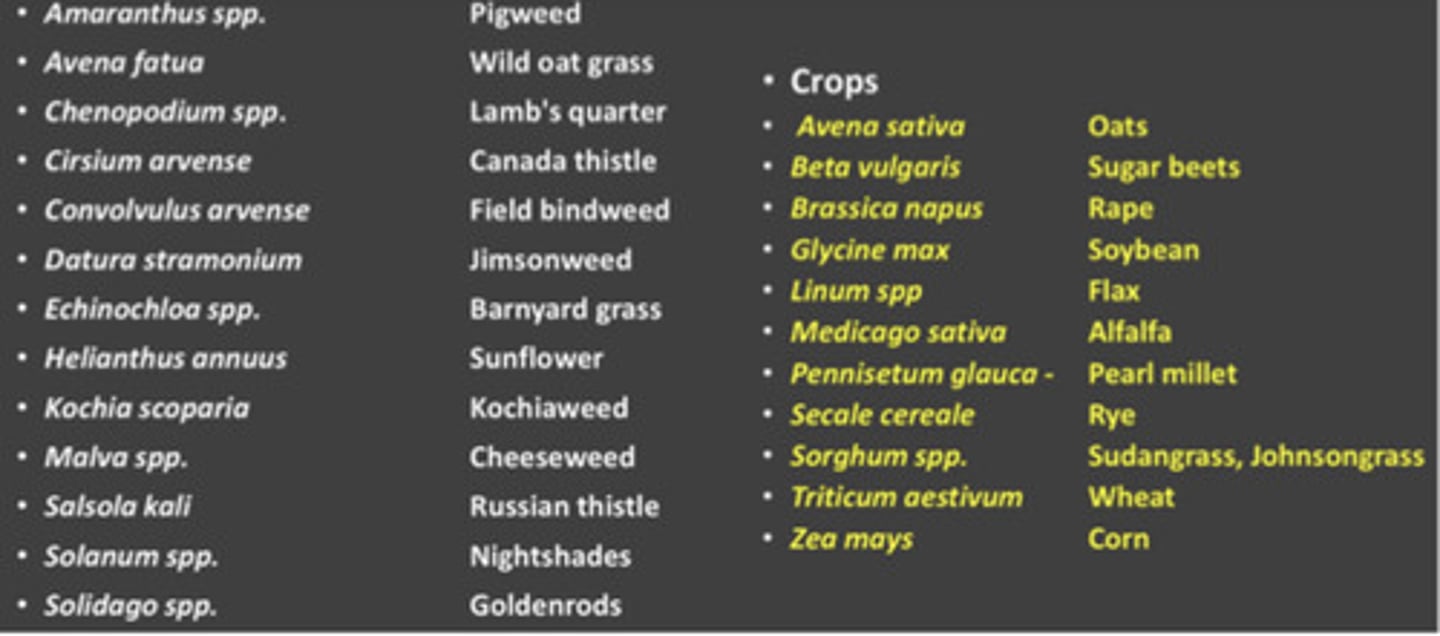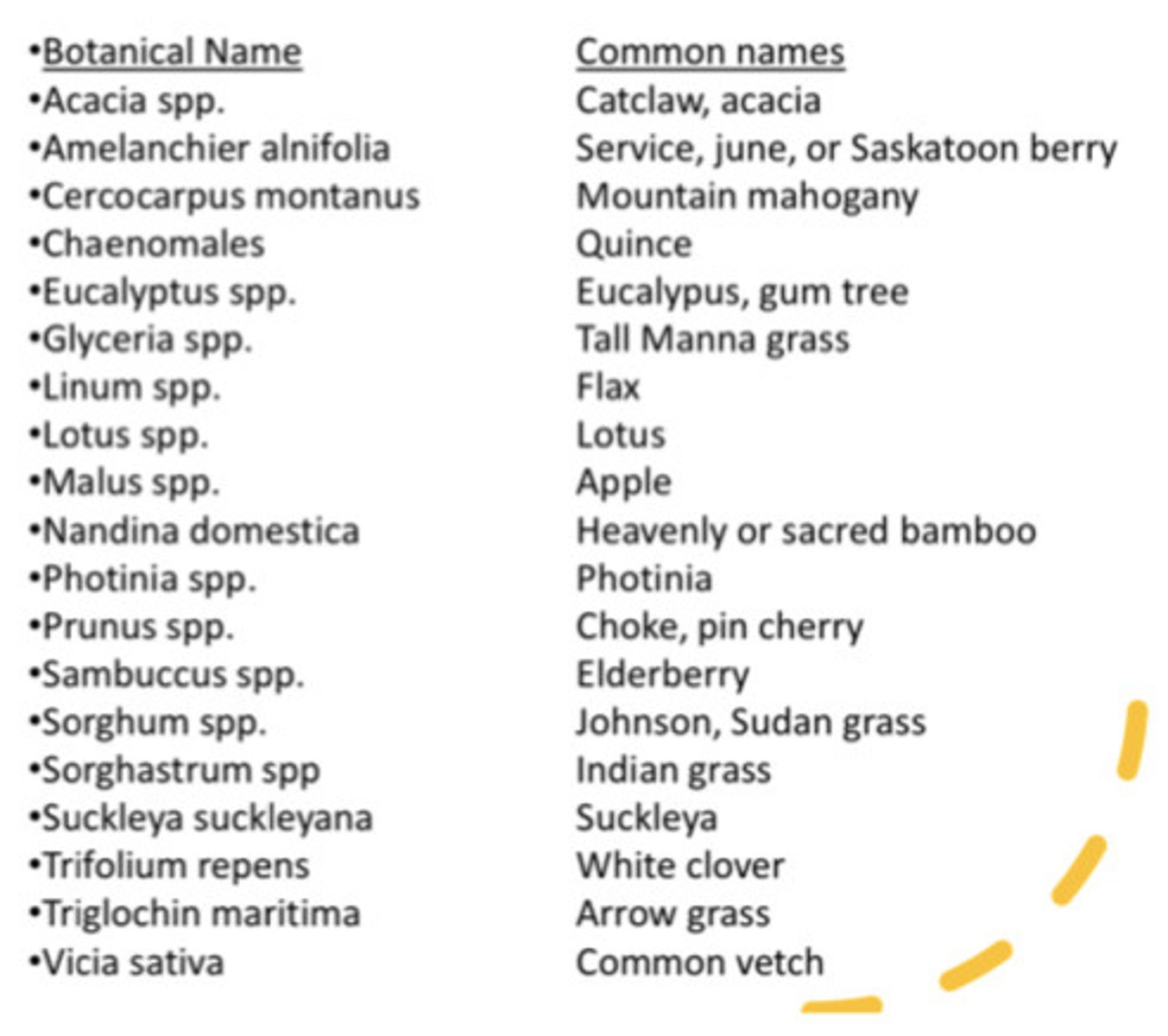Plants - Sudden Death
1/68
There's no tags or description
Looks like no tags are added yet.
Name | Mastery | Learn | Test | Matching | Spaced |
|---|
No study sessions yet.
69 Terms
Why/when do animals eat poisonous plants?
- Limited access to high-quality forage
- Contaminated hay
- Drought
- Seasonal accessibility
- Stress
Prevention of plant poisoning
-identification/removal
-characterization
-grazing management
Sudden death differential diagnosis
-infectious dz (anthrax)
-electrocution
-poisoning
What are the plants causing sudden death?
-nitrate
-cyanide
-diterpenoid alkaloids
-cardiac glycosides
-legumes (rumen bloat)
Levels elevated in
-rapidly growing
-young
-stalks/stems
-high moisture/early am
-fertilizers
-S/P/Mo deficiencies
-drought/herbicide
Mechanism
Methemoglobin!
Clinical signs
-drowsiness
-weakness
-tremors
-tachypnea/tachycardia
-brown mucosae >20%
-hypovic death >80%
Diagnostics
-aqueous humor, <60hrs, 4-5ppm
-methemoglobin, <2hrs, >40%
Toxicity forage
>1% dry forage
>0.2% aboriton
Toxicity water
>1500ppm toxic
>200ppm abortion
Treatment
Methylene blue IV
Considerations for treatment
-180d withdrawl period
-horses may develop heinz body anemia
Prevention
-adaptation
-increase carbs
-ensiling
-decrease monensin
-NOT reduced by drying/haying
Plants

Relative nitrate accumulation highest to lowest
-annual weeds
-corn
-sorghums
-cereal grains (oat hay)
-grasses
-legumes
Levels elevated in
-new growth
-cool/moist
-seeds, leaves, barks, twigs
-drought, frost, wilting, chewing (PLANT STRESS)
Mechanism
HCN binds iron and blocks cytochrome C = oxygen satyration of Hb = cellular anoxia
What favors it?
-plant damage
-water
-pH6-7 (ruminants more at risk!)
Diagnostics
-sudden death 1-2hrs
-cherry red venous blood
-pink mm, prolonged clotting
-generalized clotting/hemorrhage on necropsy
Toxicity
2mg/kg, >200ppm
Treatment
Sodium thiosulfate/sodium nitrate IV
If unsure between cyanide and nitrate poisoning, what should you give as treatment?
Methylene blue
Sudan grass poisoning
-CHRONIC
-urinary incontinence
-hindleg weakness
-may present as goiter
Plants

Which plant are we most worried about?
Sorghum
Which one is most toxic?
Tall larkspur
What makes it more toxic?
-early growth
-more sun
-all parts of plant are toxic
Mechanisms
-norditerpenoid alkaloids
-methyllycaconitine
Differences in species
Cattle > horses > sheep > goats
Age
Younger cattle may consume more and have reduced metabolism
Sex
Heifers more susceptible than steers/bulls
Breed
Dairy more susceptible
Clinical signs
-sudden death 3-4hrs
-tachycardia
-weakness/staggering
-sternal then lateral recumbency
-death from NM paralysis/bloat
-no signigicant postmorten signs besides plant in rumen
Treatment
-none proven
-place with head/chest uphill
-treat bloat
-Acetyl cholintesterase inhibitors (neostigmine)
-grazing management (mineral salt)
MONKSHOOD
-hooded flower/woody stem
-all parts toxic
-similar to larkspur
-inhibits VG Na channels
-symptomatic/supportive care
Toxin
Cicutoxin
Mechanisms
Noncompetitive inhibitor of GABA A receptors
Clinical signs
-sudden death 2-3 hrs
-violent convulsions 10-15min
-tongue biting/chewing
-bloat
-dilated pupils
-resp failure
Pathological findings
-pale areas in heart/skeletal mm
-myofiber degeneration
-elevated LDH/AST/CK
Treatment
-unlikely
-control seizures with diazepam
Mechanism
Depolarize Na+ channels causing them to remain open = hypotension/cardiovascular collapse
Toxicity
-5-60g green plant/kg
-0.6-0.7% body weight
Treatment
2mg atropine and 8mg picrotoxin per 100lbs may be effective
Toxicity
-taxine A/B
-horses > rabbits-pigs > cow-dog-sheep > goat
-.2-12 g leaves/kg
-2.3g/kg lethal dogs
-toxic when dry
Clinical signs
-sudden death
-muscle trembling
-slow heart rate/arrythmias
-V/D/convulsions
Treatment
None but can do rumenotomy, mineral oil, electrolytes, activated charcoal, IM atropine
CARDIAC GLYCOSIDES
-fox glove
-lily of the valley
-milkweeds
-oleander
-yellow oleander
-avocado
Mechanism
Block Na/K ATPase
Clinical signs
-sudden death
-cardiac arrythmias/first and second degree heart block
-abd pain/D+
Postmortem
-acute poisoning
-hemorrhage/congestion/edema/cellular degeneration
-multifocal myocardial degeneration
Treatment
-induce emesis
-oral activated charcoal
-cathartic
-monitor serum K+, IVF
-anti-arrythmic drugs
Fox glove toxin
Digitalins
Lily of the valley
-convallerin
-exposure through yard waste
Milkweeds
Exposure in hay, symptoms 8-10hrs
Oleander
0.005% BW LD, oleandrun/neriin
Yellow oleander
-thevitin
-concentrated in fruit
Avocado
-persin (inhibits Na/K+ ATPase)
-leaves are toxic, ripe fruit is nontoxic
-myocardial necrosis
-sterile mastitis
-horses = edema head/neck
-sudden death
GRAYANOTOXINS
-rhododendrons
-azaleas
-mountain laurel
-japanese pieris
Mechanism
Inhibit VG Na channel, 0.2% BW leaves
Clinical signs
-disrrythmias
-heart block
-projective V+
-D+
-ataxia/prostration
-death
Rhododendrons
-native perennial
-woody shrubs
-common to NW/SE/E
Japanese Pieris
-woody shrup
-common E/W
Treatments
-activated charcoal
-supportive care such as atropine for bradycardia
LECTINS
-castor beans
-rosary pea
-black locust
Mechanism
-glycoproteins bind to cell surface carbs to faciliate entry into cell
-inhibit ribosomal protein synthesis
Caster beans princible toxins
-ricin (mech above)
-ricinine (piperidine alkaloid found in leaves/seeds)
-ricinoleic acid (unsaturated fatty acid)
Clinical signs
1. Pyrexia, depression, anorexia, colic
2. 1-2 day lag period
3. V/weakness/hemorrhagic D+
Rosary pea
Lectin, tropical
Treatment
-emetics/laxatives
-activated charcoal
-fluid/electrolytes
-vitamin C can improve survival